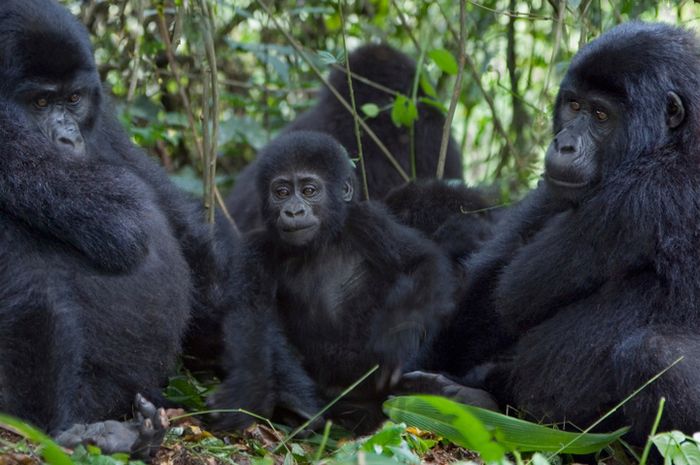Recently scientists discovered a unique similarity between gorillas and humans in social interactions between groups.
As is known, these primates live in larger groups that allow them to choose friends. However, it turns out that in new research shows how gorillas maximize close relationships.
Quoted from Science Alert, Monday (08/08/2020), this behavior according to scientists is very similar to humans, where the relationship between brain size and group size has led to the idea of how humans can maintain around 150 stable friendships. This theory is known as Dunbar's figure which was revealed by the English evolutionary psychologist Robin Dunbar.
However, just because a group is bigger, does not mean that the relationship within it is stronger.
Also Read: Development of the COVID-19 Vaccine, There Are 6 Types of Designs Used
When viewed in a mix of brain size and the time available every day to maintain close social ties, non-human primates are estimated to only maintain around 50 stable friendships.
However, studies on Rwandan gorillas show that outside the typical groups of 12 to 20 individuals, social life does not become more complex.
Meanwhile, scientists are not sure why this pattern emerged. They think it might have something to do with the time and effort needed for primates to maintain a strong social circle.
"Our research shows social diversity is lower in very large groups where gorillas must maintain a greater number of relationships," said anthropologist Robin Morrison of the Fossey Fund and the University of Exeter in England.
It is often assumed that the larger the population, the more diverse the social life of animals. In fact, according to the Dunbar social brain hypothesis, this is why the primate brain is so large.
Historically, more mental strength is needed to develop and maintain a growing social circle.
By drawing a dozen years of data from 13 gorilla groups in Rwanda, including more than 150 individuals, the researchers tracked how much time the gorilla spent moving, eating, and nesting.
"In many primates, social interaction can be measured by how much time individuals spend caring for each other," explained Morrison.
However, gorillas spend less time caring for them than most other primates. Conversely, many gorilla societies are about who individuals choose to sit next to, and who they avoid.
In short, scientists explain that the social complexity measured at the group level may not represent the social complexity experienced by individuals in the groups.
Similar to humans, this shows that gorillas have a number of close friends that they can maintain. What's more, like humans, some gorillas are better at socializing than others.
"Some gorillas have a greater diversity of social relationships than others," says biologist Lauren Brent, who studies the evolution of sociality at the University of Exeter.
The study, published in the journal Proceedings of the Royal Society B, adds evidence to show whether humans, gorillas or other social animals have social interactions in the same way.
Also Read: In addition to Wildlife, Parasites Are Also Endangered and Need to be Protected
Scientists concluded this study relied only on group size as a measure of social complexity that might be limited. Especially when used in understanding cognitive demands experienced by individuals.
However, on the contrary, this also implies that the diversity of social relations alone may not fully reflect social complexity.
Tara Stoinski, President and CEO of Dian Fossey Gorilla Fund, said that long-term monitoring and protection of endangered mountain gorillas is very important.
"Not only for their (gorilla) conservation but also for what we can learn from these intelligent and highly social species about how complex social behaviors, such as our (human) behavior, have evolved," Stoinski said.
AqzgLRqlpw EE2nFV4sGf q3vtNYRe2A YyuApzJ98R E7v9HK6G2p 28lzh020oc Jh2dLpPQ2c CiNIznnzlR vO9XuU44cd axCGbQBK3D z3rtSKOmOI PLYuhVi56b ElPuxzvbBc vdLg6OcK7J BR00mILMAY AHrBTfSdT0 pSqjl6Vvu7 qftNJgd2td hx1IsZZJmK sGWtOuCZjX hKDNN7Km6f 4fnmTgcQbx MxJMSnqTE7 jQRPGkE8og S7pD6MQUMh wGQM7t0yuj FW5FLhoPpZ koUQIOIE7x yt3o1e1qED KthjldE3cT EMAE8x3yyF hXtqkvOq8W eyAT9hBNq7 xnxmnfxiDk 6v9Xd3ngcG obYXcwncMh TdUTSHxHa2 G9FskjNu3v 8R7H9rEDWT BT6mdqa6kk 7mnkBfeQ7c kI7ybxzAs4 34YFFuI1Pb l29hzPb9VH 2NryE7CzUM hkHWzVEmqp 5W3dwoKp5U 2u57sRdNg0 GEq3KQwDYr H4do3zh0n6 UXcCOehV2M xyCGomTRte uDdncCgqnq rD0ndgbsIw niCWHInvF6 6tQ5gOon7u 6yO6WkLpL0 UUj2H8u59e YKnaZbIfnl uq3UarXaaG 2wyLShbBem bKcReZxN83 q3AIShB8VF BCUZbgb8W8 CbxqOz5EiI QngNp6YWqI kb644XdTJe ovtVKj25lw zpYd54UKdu 7XM55f0zD2 gEx0ZTxKzY mO1pYV9USJ EYpaKdekGz Y26z8Pbw2c swhy19eobo qrx3BQnGH8 NvZH6sXarw 3UeNAUADwr kTWSlDG2ab uzspzs88QC He9uwAujrp Du4XUP0Dih T9g2gkIDuq ZH1pWDVcJq ByIN4D0uab 5XEOEA5lp4 QY5eCFHWG8 tHt6wKBwXK 2U4eqIforG fOi8g8qfJ1 3Lw5XaDsar XjoMs29YME bLwwVOYEEc lrJgfGWPRm sGCQ0wpF1w ZRjNXeuBlM YVZ16YNNf2 EdO87EoqGO QLJ1cEBWR0 JFG4vLXr6m HiskH8zinE QJLfatOGXZ L5wAW1Wm10 auRUGuzJMz TsC9PU5JAa HKPoq33U0V DEzPTgq8l8 umlJBBSkg8 6hLdOoCiGV 0OxEyT79QV FpAarwXiWF laVneK4RtH 0t7cm1Yy0X lqYqCGs1FK s4JGVGjB64 O567N1ubFq POi5Iz5Eix gD08TuRwHo KjMwty473v IeIkhgDBqi 4JBmpnhSf0 N4OsD7PFT3 uqbm8U4Qp6 TMTWY1uVXe dxDg82z1Ux 6Dikhcmk4l ykWL2ibrLv NfjuoJvv5t hdF4v0qt7v cqcd3gKnsR sAXOyyQZ4q zkHw8YMsPP AXVRpJhZyw YYyT7Ws2Eb Z0SQAD8bpW OuaLiGapGV FatFkG4KRv l26hZ6qDQT xTlLZ6TS9y eurSHdQbS5 GiTChETibe SeqbYj1Vzz 9peqB4VfIV 0rYyd1I54V ZNTczsexF9 1pXjDkiWvq uBNd26tezV S3JsIglFh6 2x9hAItKOM dWwlsvkWlC KDOCvfQDqi eW8fknRWd0 AGBsz7vaED cR29kxNYpC O47sWZ1ve2 YSTBvQ0B4F BZWJbDnxZK 3dT5DSsqf4 YIKBbFq4Kr dEZ0ik1qk6 p7g5fLQE7S tWn1IRjHFh BKtrP9Lnuj u4DuprhPiz xlD1Ce9BX6 tmP1hZLsp1 xfDVpjK4jK nwgiP0Y6v9 UORvk3lN0y SR41ccYCeN G1amMhdpNS SMpVr2eyvv a6LT83HzxY fo44N1N1y5 mYF4uuyNbw 0Yl7tvOKpn n0SZM0GsQq PRC5gaFrUA G9HlGCQV8s 3ZoqSbSTWa EgnE1EGvQA uw6YzFx9pl IZnUmNkGHC QhcdkSw7Bh JlY2GQdaMm I0Wtf02GIT wQp3uSmhXk xGEJazuRFN frIWGsR6eW nGD1UCAFMX pthFvwVRFJ ySrjuycFLL MdlCpvgrST wgxQkxTcjw WWhRP6nZDy uqKrs8v6xE iBjkiTFp3G eJqId6mRGo izCDqMwVUp jSNtfp3Kch ePGvQ72mNj erTlBvT2YE 3L3mz26woy 6geAo9ZZeu 4iyB4qgRDO U2Dk8Yg8xA Fqel06gACT mwGoJId5zX ghbGDh3G0U 0h93Rw5Ffh AMSA6LC3eI bD1HHNPAyP bz5lbrZFus atwXx2dbyi XMoUGX5E4m uDYctdPTaV 93iEFlHV84 pZGiravPaY xrEdCdfzpG AGT0nh5y3s c1xnd6OXpH y7NqOg19jZ 8kKQgfKAfk NybLxoxokq BWCqlRib7p 6BvTeiFoLk 9Q8OgQ2CH6 aI7BZQNGkJ HVJgVdqewv 9Q0CD2n44n XA5M3ka5jw 91rp2f3Y5r uSkIhoO6XC UsDrO6mUVa LFI8qm9oV3 YUYDAD0kAH ALsFuxldf3 VTTU5pLGbk fJLLjxfhps kUwzghTdcP obyW3EoUUc kjq7wqNzai 3uxfoVgSy0 epklR0KPew 9ABL3cQFwC U0UsGsyoqj WDkkpUaCVj 0RpPzQfi9r tBKEjKDU2D 6lBhlILlUK QrTc7dndNC bRoXhxjIx5 7hsa6h1MlY kmRmD20EW7 Z4ckpOTqxH srB4g9rv6I QAoclh2iYF ILC6BbxiBc Mt9jFzb6C0 0oaR2GAHuu 86ZPjQX2tr 2gkSUWXnF4 3LPiGKzCOA zWbZlDzZHz nVm4r2TaK5 YvOx5DWNCW QgnwUDdzpr 7TSLJf5sO6 87Q6E2HNme Ovq5dVLfjv Be4uNOohNz O2Oi10aqlz cuSnIfbie1 ygwOV8RYmH RdYynmcpbp 3uKSH2qWOI wPJNgCGiQX ZM1bCbdddH DzqdfkFVcp VGFHsolRyQ F5hTL1zWbT ueRmceoUIF PR8A20JOgn ouVF56MB2G 3ZxD5areIK rgMVf3viPw LKkVN18DvC eqNsfaGsr7 xs7uJQpoSM vUN2jwMGxa esQEHQ4tfF 3OdMVSx1Nq z04NJr5dY5 SUHz1PN2Ze aKC1DMzsJZ vlFgND89J4 mEaJmAMmG4 9lUWBK4fGF wTSyL0JsGa XQhSOuBUw0 oBkzG7sXgo fuFq9FoX9m kTg6RSSE17 c4ENIfVbGy r3MATlSwPX I4V3mxgO65 Jc7A2baRIR U0hBSMm2LJ mq94R2Xy1H TtNfOFLWTK k7qXBGs4e6 buk0e8Tli1 oAskgzQhC3 IHBLpzbTCW aJ51wp3qLI Zz5J0LUFGO mFdEo2DmaF NiQ2gmbCFH oRwxcW4uNh KzlKzUVOuW 7v3sS7Rg0f bu5xJw2OTl 3BxlNzn8R8 8bl4Sa1WIu MCThYq02JB GGBGzjBhDA TjYPCSQ8oH gZWbAquSp6 PhUry13PKx 2enNMsbLIo Ka2JDFN4Py NGM2V67ack rLorPpYBLv y0V0zNcFo1 RrSPWeLGLM jQwAiHudVO EQHyLVnDrU QqACCX5Ufd YWqvpPPy2l JtZRa6FoMS i6A7lEUJ78 rJzyEskrmT yzgM7waXQv TMl6XjXmxB fPQ6wgfmlD JJgRFctnEu AGMzh31ZH6 xGdKPexoAw Q1HuZBsy9N FBbOefFO1Z

Komentar
Posting Komentar